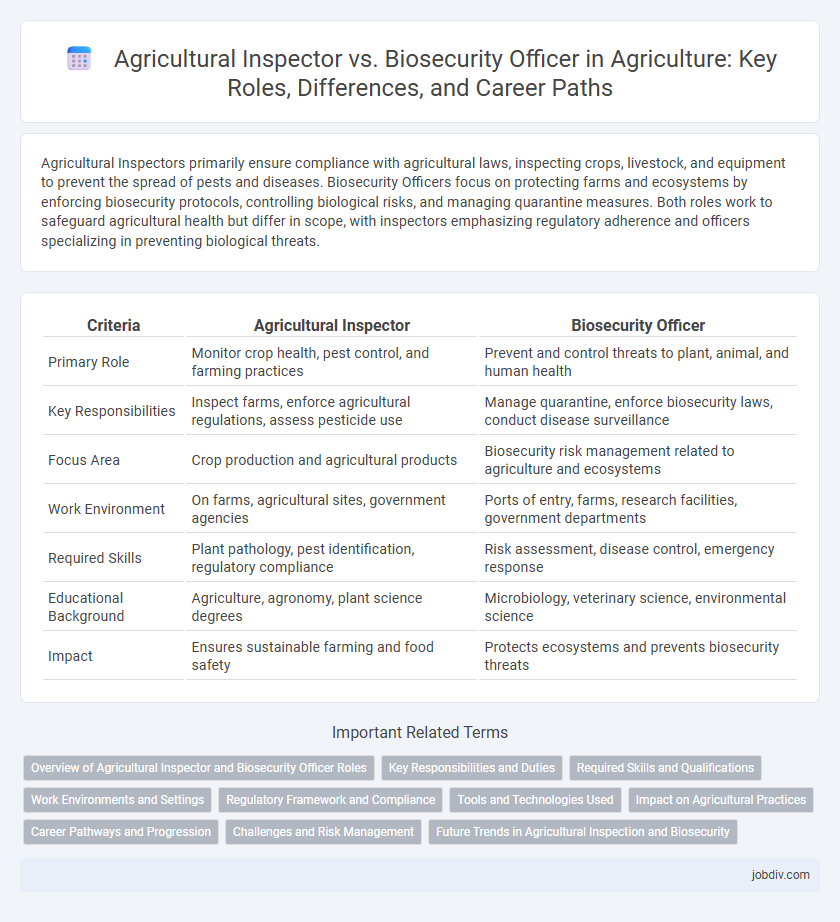Agricultural Inspectors primarily ensure compliance with agricultural laws, inspecting crops, livestock, and equipment to prevent the spread of pests and diseases. Biosecurity Officers focus on protecting farms and ecosystems by enforcing biosecurity protocols, controlling biological risks, and managing quarantine measures. Both roles work to safeguard agricultural health but differ in scope, with inspectors emphasizing regulatory adherence and officers specializing in preventing biological threats.
Table of Comparison
| Criteria | Agricultural Inspector | Biosecurity Officer |
|---|---|---|
| Primary Role | Monitor crop health, pest control, and farming practices | Prevent and control threats to plant, animal, and human health |
| Key Responsibilities | Inspect farms, enforce agricultural regulations, assess pesticide use | Manage quarantine, enforce biosecurity laws, conduct disease surveillance |
| Focus Area | Crop production and agricultural products | Biosecurity risk management related to agriculture and ecosystems |
| Work Environment | On farms, agricultural sites, government agencies | Ports of entry, farms, research facilities, government departments |
| Required Skills | Plant pathology, pest identification, regulatory compliance | Risk assessment, disease control, emergency response |
| Educational Background | Agriculture, agronomy, plant science degrees | Microbiology, veterinary science, environmental science |
| Impact | Ensures sustainable farming and food safety | Protects ecosystems and prevents biosecurity threats |
Overview of Agricultural Inspector and Biosecurity Officer Roles
Agricultural Inspectors primarily enforce regulations related to crop health, pesticide use, and livestock welfare to ensure compliance with agricultural standards. Biosecurity Officers focus on preventing the introduction and spread of pests, diseases, and invasive species through monitoring, risk assessment, and quarantine enforcement. Both roles are essential for safeguarding national food security and maintaining ecosystem health within agricultural systems.
Key Responsibilities and Duties
Agricultural Inspectors primarily focus on monitoring crop health, enforcing agricultural regulations, and ensuring compliance with pest control standards to protect farm productivity. Biosecurity Officers concentrate on preventing the introduction and spread of pests and diseases through border control, quarantine enforcement, and risk assessment protocols. Both roles collaborate to safeguard agricultural ecosystems but differ in scope, with Inspectors targeting on-farm compliance and Officers managing broader biosecurity threats at national entry points.
Required Skills and Qualifications
Agricultural Inspectors require expertise in plant and animal health, knowledge of agricultural laws and regulations, and strong analytical skills to assess compliance and identify risks. Biosecurity Officers must possess specialized training in biosecurity protocols, disease control measures, and emergency response, along with qualifications in veterinary science or environmental health. Both roles demand attention to detail, effective communication abilities, and certifications related to agriculture and biosecurity standards.
Work Environments and Settings
Agricultural Inspectors typically work in diverse environments including farms, processing plants, and markets to ensure compliance with agricultural laws and safety standards. Biosecurity Officers operate primarily at national borders, ports, and quarantine facilities to prevent the introduction and spread of pests and diseases that threaten agriculture. Both roles require field inspections, but Biosecurity Officers often engage in high-security settings focused on containment and monitoring of biological threats.
Regulatory Framework and Compliance
Agricultural Inspectors enforce compliance with domestic agricultural laws, focusing on crop health, pesticide use, and livestock welfare under regulations like the Plant Protection Act and the Animal Health Protection Act. Biosecurity Officers operate within a broader regulatory framework, including international standards such as the World Organisation for Animal Health (OIE) guidelines, ensuring biosecurity measures prevent the introduction and spread of pests and diseases across borders. Both roles require adherence to federal and state regulations, but Biosecurity Officers emphasize quarantine protocols and import/export controls to maintain national agricultural biosecurity.
Tools and Technologies Used
Agricultural Inspectors utilize portable diagnostic kits, mobile apps for data collection, and drones for crop and livestock monitoring to detect pests and ensure compliance with agricultural standards. Biosecurity Officers employ advanced scanning devices, pathogen detection sensors, and geographic information systems (GIS) to prevent the introduction and spread of invasive species and diseases across borders. Both professionals rely on real-time data analytics and remote sensing technologies to enhance biosecurity measures and safeguard agricultural ecosystems.
Impact on Agricultural Practices
Agricultural Inspectors enforce regulatory compliance by monitoring crop health, pesticide use, and farm equipment standards, ensuring sustainable agricultural practices and food safety. Biosecurity Officers focus on preventing the introduction and spread of pests and diseases through quarantine measures and risk assessments, protecting ecosystem integrity and agricultural productivity. Both roles critically influence biosecure and efficient farming operations, mitigating risks that threaten crop yields and market access.
Career Pathways and Progression
Agricultural Inspectors typically begin their careers with entry-level roles in regulatory compliance, advancing to specialized inspection or supervisory positions by gaining expertise in crop health, pest control, and food safety standards. Biosecurity Officers often start with fieldwork in quarantine and disease prevention, progressing through roles involving risk assessment, biosecurity planning, and emergency response coordination to protect ecosystems and agriculture from invasive species. Career progression for both roles involves continual professional development, certifications in biosecurity protocols, and opportunities to move into policy advisory or management within government or private sector agencies.
Challenges and Risk Management
Agricultural Inspectors face challenges in identifying plant diseases and pesticide violations, requiring meticulous risk assessment to prevent crop loss and ensure food safety. Biosecurity Officers manage risks related to invasive species and zoonotic diseases, implementing stringent quarantine measures to protect ecosystems and public health. Both roles demand continuous monitoring and rapid response strategies to mitigate biosecurity threats effectively.
Future Trends in Agricultural Inspection and Biosecurity
Emerging technologies like AI-driven imaging and drone surveillance are reshaping the roles of Agricultural Inspectors and Biosecurity Officers by enabling faster detection of pests and diseases across larger areas. The integration of IoT sensors and real-time data analytics enhances early warning systems for biosecurity threats, allowing proactive responses to invasive species and contamination risks. Future trends emphasize cross-disciplinary collaboration and automation to improve accuracy, efficiency, and overall resilience in agricultural inspection and biosecurity measures.
Agricultural Inspector vs Biosecurity Officer Infographic

 jobdiv.com
jobdiv.com